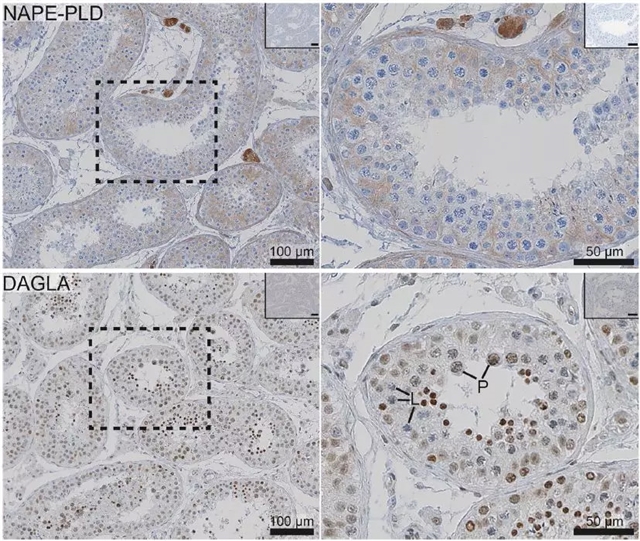|
|
| 内源性大麻素系统可能参与人睾丸生理调节 |《科学报告》 |
|
论文标题:Characterisation and localisation of the endocannabinoid system components in the adult human testis
期刊:Scientific Reports
作者:John E. Nielsen, Antoine D. Rolland, Ewa Rajpert-De Meyts, Christian Janfelt, Anne Jørgensen, Sofia B. Winge, David M. Kristensen, Anders Juul, Frédéric Chalmel, Bernard Jégou,Niels E. Skakkebaek
发表时间:2019/09/19
数字识别码:10.1038/s41598-019-49177-y
微信链接:https://mp.weixin.qq.com/s/FwEDmKpCixz5Z7TDM55S0w
《科学报告》发表的一项研究Characterisation and localisation of the endocannabinoid system components in the adult human testis通过考察15位患者的组织样本发现,内源性大麻素系统(ECS)可能直接参与了人睾丸的生理调节,包括精细胞发育。

图1:人睾丸中内源性大麻素合成酶的免疫组化表达 图源: Nielsen等
内源性大麻素是一种神经递质。ECS是由内源性大麻素以及大麻素相关受体、酶和蛋白共同组成的一个信号传导系统。在人体内,ECS一直被认为与精子质量和功能有关。不过,此前甚少有信息表明ECS成分在人睾丸组织中是否存在,以及它们在精细胞发育中的可能作用。
丹麦哥本哈根Rigshospitalet医院的Niels E. Skakkebaek和同事收集了15位睾丸生殖细胞癌患者的睾丸组织样本,并考察其中是否存在ECS的各种成分。作者发现,人睾丸中确实存在ECS成分,包括主要的内源性大麻素——2-花生四烯酰甘油酯(2-AG)。此外,作者还在精细胞发育的各阶段发现了FAAH和ABHD2一类的2-AG降解酶以及内源性大麻素受体,并在不同的精细胞发育成熟期检测到了不同的ECS组成模式。
研究结果显示,ECS不仅存在于人睾丸中,还可能参与了睾丸功能、尤其是精细胞发育的调节。研究结果丰富了已有认知,即大麻使用与年轻男性的精液质量和生殖激素水平变化相关。不过,内源性大麻素在人体生殖器官中的功能仍需进一步研究,以明确大麻使用可能造成的健康影响。
摘要:Heavy use of cannabis (marijuana) has been associated with decreased semen quality, which may reflect disruption of the endocannabinoid system (ECS) in the male reproductive tract by exogenous cannabinoids. Components of ECS have been previously described in human spermatozoa and in the rodent testis but there is little information on the ECS expression within the human testis. In this study we characterised the main components of the ECS by immunohistochemistry (IHC) on archived testis tissue samples from 15 patients, and by in silico analysis of existing transcriptome datasets from testicular cell populations. The presence of 2-arachidonoylglycerol (2-AG) in the human testis was confirmed by matrix-assisted laser desorption ionization imaging analysis. Endocannabinoid-synthesising enzymes; diacylglycerol lipase (DAGL) and N-acyl-phosphatidylethanolamine-specific phospholipase D (NAPE-PLD), were detected in germ cells and somatic cells, respectively. The cannabinoid receptors, CNR1 and CNR2 were detected at a low level in post-meiotic germ cells and Leydig- and peritubular cells. Different transcripts encoding distinct receptor isoforms (CB1, CB1A, CB1B and CB2A) were also differentially distributed, mainly in germ cells. The cannabinoid-metabolising enzymes were abundantly present; the α/β-hydrolase domain-containing protein 2 (ABHD2) in all germ cell types, except early spermatocytes, the monoacylglycerol lipase (MGLL) in Sertoli cells, and the fatty acid amide hydrolase (FAAH) in late spermatocytes and post-meiotic germ cells. Our findings are consistent with a direct involvement of the ECS in regulation of human testicular physiology, including spermatogenesis and Leydig cell function. The study provides new evidence supporting observations that recreational cannabis can have possible deleterious effects on human testicular function.
(来源:科学网)
特别声明:本文转载仅仅是出于传播信息的需要,并不意味着代表本网站观点或证实其内容的真实性;如其他媒体、网站或个人从本网站转载使用,须保留本网站注明的“来源”,并自负版权等法律责任;作者如果不希望被转载或者联系转载稿费等事宜,请与我们接洽。